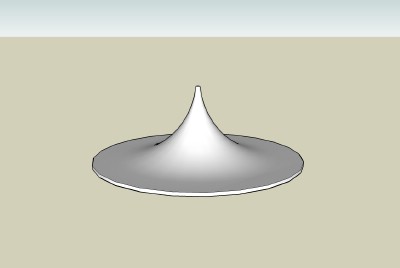Brisbane.
I'm back in the country (and off to the Mobile Media conference in Sydney tomorrow), and I'm continuing to work through my produsage book, whose working title may have shifted again - we're looking at Blogs, Wikipedia, Second Life, and Beyond: The Shift from Production to Produsage as an option now.
In the book, I'm working with a number of graphs to clarify the concepts I'm using. For one of them, I'm coming up against the limits of my design skills, so in true produsage style, I'm wondering if anybody reading this may be able to offer their talents? I'll acknowledge your contribution in the book, of course! Below is the passage in question, and my first sketch for the graph. What it should show is the tall peak and soft slope I'm talking about - basically a version of the classic 'long tail' graph turned 360 degrees around its vertical axis, perhaps with an overlaid texture that indicates the location of interest community clusters clusters on the soft slope. Any takers? Email me... (The image will need to be hi-res, and work in black & white print on paper, of course...)
Where they find success, such niche-driven production models are likely over time to substantially alter the operations of traditional media, the avail-able overall media mix, as well as our cultural frameworks themselves. To begin with, the more the operation of niche production and distribution approaches is finding success, the less 'niche' do such approaches become; the success of niche programming will contribute to a swelling of the enthusiast communities themselves, and thereby shift the balance between mainstream and off-mainstream further in favor of the many communities existing in the long tail of cultural diversity outside of the tall peak of popular, mass culture.
With consumers not only being comfortable wandering further from the beaten path, but the beaten path also being much easier to leave … , they discover their taste is not as mainstream as they thought. Mass popularity was based more on what was available (think mass marketing budgets, limited physical shelf space, limited broadcasting channels, and a nearly complete lack of transparency), than on absolute laws of nature that dictated 'good' or 'bad'. [Trendwatching 8.3]
The net result is not a simple replacement of mainstream and non-mainstream tastes, however - this is no simple reversal of the peaks and troughs on the long tail graph. Indeed, that graph itself is somewhat misleading, as it condenses the many and varied cultural options existing outside of the mainstream of mass culture into a single, one-dimensional line. In reality, it would perhaps be more appropriate to speak of a soft slope falling away in all directions from the tall peak of common-denominator mass culture, surrounding that peak in a 360 degree circle. Different sections of that slope represent different taste cultures which have found their home there, and these cultures and communities sometimes overlap considerably, and sometimes police their boundaries with a quasi-religious zeal; some communities will allow their members to have many other citizenships, some will require commitment only to the one true culture. At any rate, there is no longer any one publisher, broadcaster, or other media producer whose message reaches and unites all the inhabitants of that slope extending to the horizon-some continue to broadcast from the highest peak in hopes of reaching the largest possible audience, but many have chosen instead to set up community stations in various locations further down the valleys.













